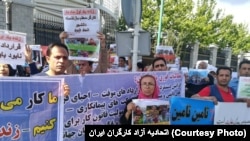After weeks of delays the Iranian government has offered workers a relatively small salary adjustment, which is half of the country’s 41 percent inflation rate.
The government announced the minimum net monthly wage for the next 12 months to be a little more than 18 million rials. That sounds big, but according to the real, free market exchange rate it equals $115.
It is important to calculate wages in Iran based on the free market exchange rate, rather than the government’s fictitious rate, which puts the value of Iran’s currency fourfold higher than what a person can get on the street.
Prices of everyday necessities, which workers have to buy, reflect the free market exchange rate of one USD to 160,000 rials.
The decision that was made Wednesday evening, April 8 announced the cost of living increase after 40 hours of negotiations between the representatives of workers, employers and the Labor Ministry shows a minimum wage raise of 21 percent compared to last year.
This comes while the Central Bank of Iran (CBI) has announced that inflation for last year was 41 percent and estimated the current year's inflation rate at around 50 percent. There fore workers got a pay raise roughly half of price inflation in the country.
The agreement made by the three groups of representatives at High Council of Labor was made belatedly as a previous meeting in March had remained futile as workers demanded a minimum of 45 percent pay rise for the new year that started March 20.
According to the Iranian Labor News Agency (ILNA), the employers were insisting at the previous meeting that they cannot afford a raise beyond 15 percent.
Based on article 41 of the Iranian Labor Law, the High Council of Labor should determine the minimum wage on an annual basis proportionate to the inflation rate, and make sure that the minimum wage can cover the expenses of an ordinary family.
According to the Iranian Statistical Center the cost of living for Iranian families has risen by 64 percent between March 2019 and March 2020.
However, labor activists maintain that although minimum wage is being determined every year, officials at the High Council of Labor have ignored the cost of living in their calculations for many years now.
With the amendments made this year in the housing and foodstuff allowances, the total amount paid to a single worker in Iran will be 25,000,000 rials or $155 [$597.10] and married workers will receive nearly 30,000,000 rials monthly.
Workers interviewed by ILNA say this will not be enough to cover the cost of food they consume, let alone paying for housing, clothing, travel, medical and educational expenses of their families.
According to the Iranian news agencies the workers' representative at the meeting refused to sign off on the deal. Reformist website Jamaran in Iran has published a copy of the meeting's final statement which has not been signed by the workers' representatives.
In March 2019 the research center of the Iranian parliament (Majles) determined the poverty line in Iran at 34,000,000 rials which is higher than the minimum wage determined for married workers this year. Therefore, all the new minimum wage earners will be effectively categorized as citizens below the poverty line.
The High Council of Labor's own estimate of the cost of living for an ordinary family is 54,000,000 rials or $340 a month.
Nevertheless, Labor Minister Mohammad Shariatmadari claimed this year’s minimum wage will be enough to cover the costs of a family of 3.3 people.
While Shariatmadari has characterized the 21 percent pay rise for minimum wage earners as "positive," the foreign-based labor union of Iranian workers has opined that the raise is "humiliating."






